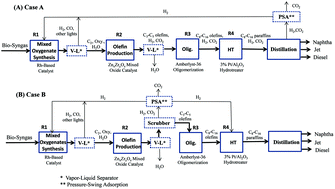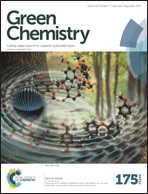Integrated process for the catalytic conversion of biomass-derived syngas into transportation fuels
Abstract
Efficient synthesis of renewable fuels that will enable cost competitiveness with petroleum-derived fuels remains a grand challenge. In this paper, we report on an integrated catalytic approach for producing transportation fuels from biomass-derived syngas. This novel process represents an alternative to conventional fuel synthesis routes (e.g., Fischer–Tropsch, Methanol-to-Gasoline) that have drawbacks, particularly at the scale of biomass. Composition of the resulting hydrocarbon fuel can be modulated to produce predominantly middle distillates, which is constantly increasing in demand compared to gasoline fraction. In this process biomass-derived syngas is first converted over an Rh-based catalyst into a complex aqueous mixture of condensable C2+ oxygenated compounds (predominantly ethanol, acetic acid, acetaldehyde, ethyl acetate). This multi-component aqueous mixture then is fed to a second reactor loaded with a ZnxZryOz mixed oxide catalyst, which has tailored acid–base sites, to produce an olefin mixture rich in isobutene. The olefins then are oligomerized using a solid acid catalyst (e.g., Amberlyst-36) to form condensable olefins with molecular weights that can be targeted for gasoline, jet, and/or diesel fuel applications. The product rich in long-chain olefins (C7+) is finally sent to a fourth reactor required for hydrogenation of the olefins into paraffin fuels. Simulated distillation of the hydrotreated oligomerized liquid product indicates that ∼75% of the hydrocarbons (iso-paraffins and cyclic compounds) are in the jet-fuel range. Process optimization for the oligomerization step could further improve yield to the jet-fuel range. All of these catalytic steps have been demonstrated in sequence, thus providing proof-of-concept for a new integrated process for the production of drop-in biofuels. Overall, we demonstrate approximately 41% carbon efficiency for converting syngas into jet-range hydrocarbons. This unique and flexible process does not require external hydrogen and also could be applied to non-syngas derived feedstock, such as fermentation products (e.g., ethanol, acetic acid, etc.), other oxygenates, and mixtures thereof containing alcohols, acids, aldehydes and/or esters.


 Please wait while we load your content...
Please wait while we load your content...